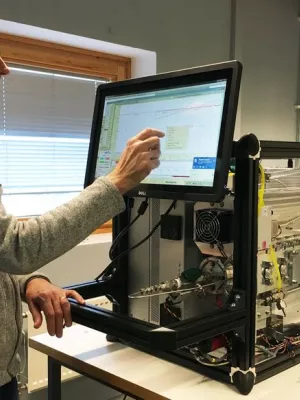
Erik Swietlicki
Professor

Organic aerosol concentration and composition over Europe: insights from comparison of regional model predictions with aerosol mass spectrometer factor analysis
Author
Summary, in English
A detailed three-dimensional regional chemical transport model (Particulate Matter Comprehensive Air Quality Model with Extensions, PMCAMx) was applied over Europe, focusing on the formation and chemical transformation of organic matter. Three periods representative of different seasons were simulated, corresponding to intensive field campaigns. An extensive set of AMS measurements was used to evaluate the model and, using factor-analysis results, gain more insight into the sources and transformations of organic aerosol (OA). Overall, the agreement be-tween predictions and measurements for OA concentration is encouraging, with the model reproducing two-thirds of the data (daily average mass concentrations) within a factor of 2. Oxygenated OA (OOA) is predicted to contribute 93% to total OA during May, 87% during winter and 96% during autumn, with the rest consisting of fresh primary OA (POA). Predicted OOA concentrations compare well with the observed OOA values for all periods, with an average fractional error of 0.53 and a bias equal to -0.07 (mean error = 0.9 mu g m(-3), mean bias =-0.2 mu g m(-3)). The model systematically underpredicts fresh POA at most sites during late spring and autumn (mean bias up to -0.8 mu g m(-3)). Based on results from a source apportionment algorithm running in parallel with PMCAMx, most of the POA originates from biomass burning (fires and residential wood combustion), and therefore biomass burning OA is most likely underestimated in the emission inventory. The sensitivity of POA predictions to the corresponding emissions' volatility distribution is discussed. The model performs well at all sites when the Positive Matrix Factorization (PMF)-estimated low-volatility OOA is compared against the OA with saturation concentrations of the OA surrogate species C* <= 0.1 mu g m(-3) and semivolatile OOA against the OA with C* > 0.1 mu g m(-3).
Department/s
- Nuclear physics
- MERGE: ModElling the Regional and Global Earth system
Publishing year
2014
Language
English
Pages
9061-9076
Publication/Series
Atmospheric Chemistry and Physics
Volume
14
Issue
17
Document type
Journal article
Publisher
Copernicus GmbH
Topic
- Subatomic Physics
Status
Published
ISBN/ISSN/Other
- ISSN: 1680-7324